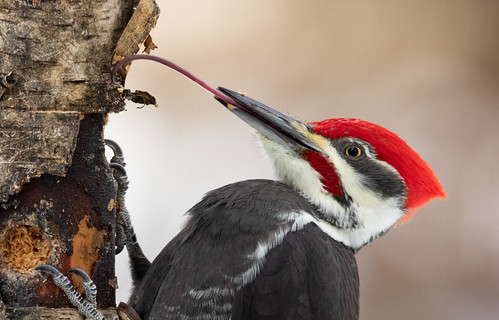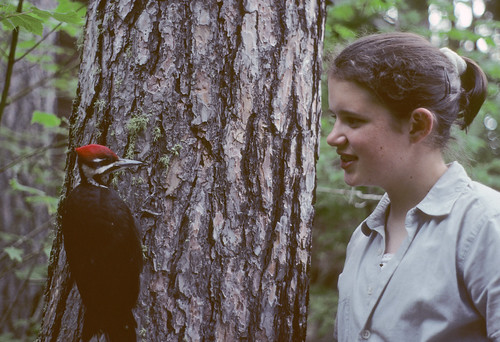Back in June 1998, I was brought a newly fledged Pileated Woodpecker. The little guy—well, the big little guy, because he was already full sized—was at that wonderful stage babies go through of trying to figure out the world and how things work. I only had Gepetto about a week before I was scheduled to teach a 2-week Elderhostel class on Burntside Lake near Ely. I brought him along and hoped that during those two weeks he could adapt to living in the wild. Watching him explore, I wrote:
[Gepetto] was like a toddler in a highchair, dropping insects and flakes of bark to the ground and watching them fall. And like a toddler, he tasted everything, probing under the edges of bark with his long slurpy tongue.
 |
| Not Gepetto, but this is the only photo I have of a Pileated Woodpecker's tongue. |
He learned to eat the insects that adhered to his tongue before he learned to eat insects he could actually see. For a few days he would pick up spiders and insects in his beak and then drop them, apparently for the fun of it or simply to see what happened, but in mid-week he suddenly discovered that bugs walking about in the open are the exact same insects that taste so good when his tongue pulls them from inside crevices. It was fun watching the lightbulb go on in his little bird brain whenever he made a discovery like this.
There was a Pileated Woodpecker pair nesting in the same area where I was releasing Gepetto. When Gepetto first heard their voices, he called right back, but they attacked him mercilessly as an invader on their territory. So Gepetto’s first lesson was to stay very, very quiet when they were about.
I’m appreciating these memories all the more right now, as I watch my 5-month-old baby grandson figure things out. He’s not at the dropping things and watching them fall stage yet—when he drops anything, it seems to have disappeared, and he instantly starts looking at something else. Baby birds learn some lessons much more quickly than baby humans.
One thing I’ve been fascinated with is Walter’s reaction to mirrors. He has a mirror on the little pad where he practices tummy time. When he smiles, the baby in the mirror smiles right back at him, and when Walter is sad or mixed up, the baby in the mirror looks pretty sad or mixed up, too. Sometimes Walter can see me in the mirror, but when he turns to see me in real life, he seems to think there are two different Grandmas involved.
When I was rehabbing and raised baby Blue Jays, several times I brought one to the bathroom mirror to see how it would react. Invariably, the little jay raised its crest and tapped on the mirror with its beak, but then it looked at me in the mirror, looked at me in real life, and seemed to figure it out. Usually by the second and always by the third time at the mirror, Blue Jays seemed to realize it was nothing more than their own reflection.
Robins and cardinals never seem to be able to figure out reflections—an individual may dash itself into a window over and over for days or weeks without figuring out that there really isn’t a real live bird there.
But there is solid proof that at least one corvid does. In a wonderful experiment, researchers marked a dot on the black lower throat area of some lone magpies, precisely where the birds could not see it. When they placed a mirror in front of the magpies and they saw the reflection, they started scratching away on the mark where they saw it from their reflection.
Walter will catch up with basic corvid responses to mirrors soon.
It’s fun belonging to one of the more intelligent species on the planet, being able to compare how we develop our abilities with how other intelligent species do.



